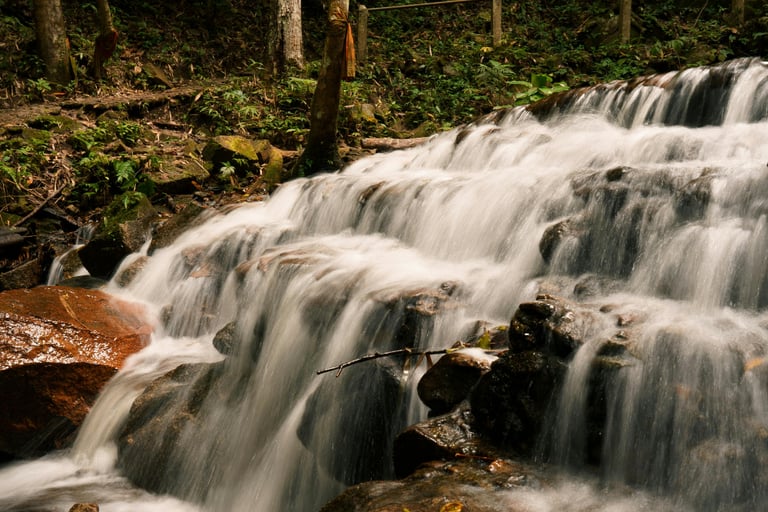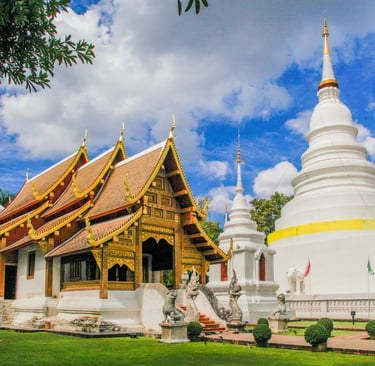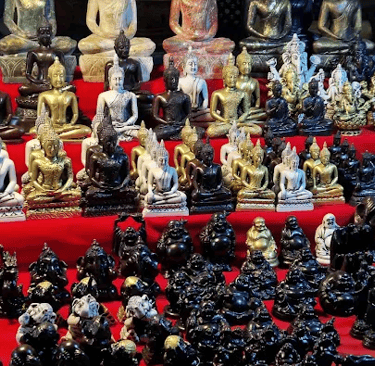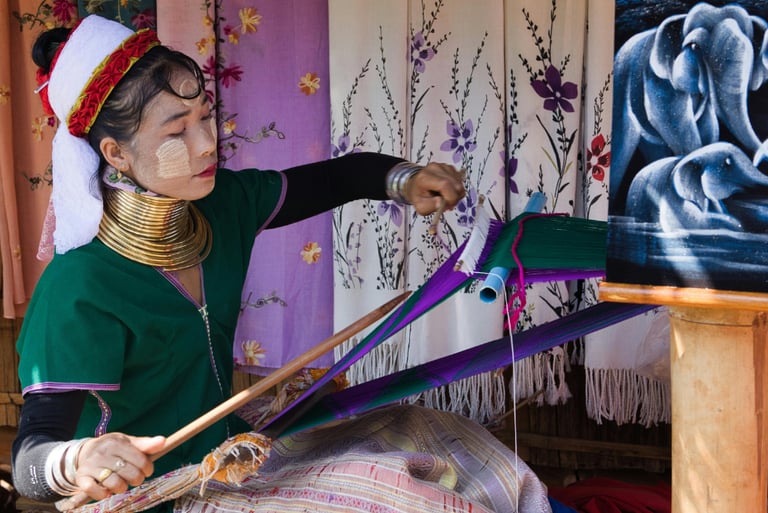Chiang Mai for First-Timers: 10 Essential Dos and Don'ts for a Perfect Trip
Chiang Mai for First-Timers l First time in Chiang Mai? Get the 10 essential dos and don'ts you must know. Our local guide covers temples, etiquette, & safety for a perfect trip.
11/16/202510 min read


A First-Timer’s Ultimate Guide to Chiang Mai: 10 Essential Dos and Don'ts for a Perfect Trip
Welcome to Chiang Mai! Sawasdee khrub/ka! You’ve chosen one of the most magical, enchanting, and soulful destinations in all of Southeast Asia. Known as the "Rose of the North," this city is a vibrant blend of ancient history, breathtaking nature, profound culture, and a wonderfully relaxed pace of life.
Unlike the bustling, modern metropolis of Bangkok or the sun-drenched beaches of the south, Chiang Mai offers something truly unique. It’s a city nestled in a lush green valley, surrounded by mountains, where moats still encircle the 700-year-old Old City and hundreds of glittering temples stand as testaments to its history as the capital of the Lanna Kingdom.
But for a first-time visitor, navigating this cultural richness can feel a little overwhelming. What are the unspoken rules? How do you show respect? What are the common mistakes to avoid? And how do you go beyond the surface to have a truly authentic experience?
That’s where this guide comes in. As locals, we want you to fall in love with our city just as much as we have. We’re here to share the essential dos and don'ts that will help you navigate your journey with confidence, respect, and the warmth of a local. This isn’t just about avoiding a faux pas; it’s about opening doors to more meaningful interactions and creating a perfect, unforgettable trip.
Let’s dive in.




The 5 Essential DOs of Chiang Mai
1. DO: Embrace and Respect Lanna Culture
This is, without a doubt, the most important piece of advice we can offer. You are a guest in a land with deep, complex, and beautiful traditions. The Lanna culture of Northern Thailand is distinct even from the rest of the country, known for its gentle spirit, artistic heritage, and deep Buddhist faith.
Respecting the Monarchy: Thailand is a constitutional monarchy, but the reverence for the King and the Royal Family is immense and deeply woven into the cultural fabric. You will see portraits of the King everywhere. It is illegal and deeply offensive to criticize, deface images of, or make jokes about the monarchy. When the King's Anthem plays in public (often at 8 AM and 6 PM in places like train stations or markets), you’ll notice locals stop what they're doing and stand still. It is polite and respectful for you to do the same.
Respecting Buddhism: The religion is a way of life here. You will see monks (dressed in saffron or orange robes) everywhere. Monks are highly revered.
For Women: It is forbidden for a woman to touch a monk. If you need to hand something to a monk, place it on a surface for him to pick up or pass it to a man to give to him. On a songthaew (red truck taxi), a woman should not sit directly next to a monk.
For Everyone: Always show respect. Give monks priority seating. When in a temple, never sit with your back to the Buddha image, and never point at one (we’ll cover pointing later).
By leading with a smile, a patient attitude, and a clear display of respect, you’ll find that locals are incredibly welcoming and forgiving. They will appreciate your effort, and it will fundamentally change the quality of your interactions.
2. DO: Dress Respectfully, Especially at Temples
This is a practical extension of cultural respect. Chiang Mai is a city of over 300 temples, and you will absolutely be visiting them. "Temple-hopping" is a core part of the experience, but these are active, sacred places of worship, not just tourist attractions.
"Respectful dress" means covering your shoulders and your knees. This applies to both men and women.
Avoid: Tank tops, strappy tops, spaghetti straps, crop tops, very short shorts, and mini-skirts.
Do: Wear t-shirts, polo shirts, blouses, and shorts, skirts, or trousers that go to or past the knee.
Many first-timers make the mistake of thinking, "Oh, it's so hot, I'll just wear my tank top." This can lead to you being respectfully denied entry to major temples like Wat Phra That Doi Suthep or Wat Chedi Luang. While many temples at the entrance offer shawls or sarongs for rent (usually for a small fee or a deposit), it’s far easier and more respectful to come prepared.
A fantastic local tip is to buy a lightweight, beautiful elephant-print or patterned shawl from a local market on your first day. It’s cheap, easy to carry in your bag, and you can instantly drape it over your shoulders or tie it around your waist when you decide to pop into a temple. It's the perfect functional souvenir.


3. DO: Eat Adventurously (and Safely!)
You are about to enter a culinary paradise. Northern Thai food is a world of its own, distinct from the sweet-and-spicy coconut curries of the south. It’s characterized by herbaceous, savory, and often fiery flavors, with influences from neighboring Myanmar, Laos, and China.
The Must-Try King: Khao Soi. If you only eat one dish, make it this. It’s a glorious, fragrant curry noodle soup, typically with a chicken drumstick, topped with crispy fried noodles, and served with a side of pickled mustard greens, shallots, and lime. It’s pure comfort and joy in a bowl.
But don’t stop there!
Sai Oua: The famous Chiang Mai sausage. It's a spiral of pork packed with herbs like lemongrass, kaffir lime leaves, and galangal. Find it grilling on street corners.
Nam Prik Ong / Nam Prik Noom: Two iconic dips. Nam Prik Ong is a mild, tomato-pork chili dip, while Nam Prik Noom is a green, smoky, and spicy dip made from roasted green chilies. Eat them with fresh vegetables and sticky rice.
Gaeng Hung Lay: A rich, savory, and sweet pork belly curry with Burmese influences, fragrant with ginger, tamarind, and turmeric.
What about street food? YES. Embrace it! Some of the best food in the city is found at street stalls and night markets. A good rule of thumb: If you see a lot of locals eating there, it’s safe and it’s delicious. Go to the stalls at the Chiang Mai Gate (South Gate) or Chang Phueak (North Gate) for an unforgettable feast. Just remember to drink bottled water, and you’ll be fine.
4. DO: Learn a Few Key Thai (and Local) Phrases
You can absolutely get by with English in tourist centers, but even a tiny effort to speak the local language will transform your experience. It breaks down barriers, shows respect, and will be met with beaming smiles (and sometimes better prices).
The Essentials:
Hello / Goodbye: "Sawasdee" (sa-wat-dee)
Thank You: "Khop Khun" (kop-koon)
Yes: "Chai" (chai)
No: "Mai" (my)
How much? "Tao Rai?" (tao-rye)
The Magic Words: To be polite, you must end your sentences with a particle.
If you are female: Add "Ka" (kâ) to the end. (e.g., "Khop Khun Ka")
If you are male: Add "Krub" (krúb) to the end. (e.g., "Khop Khun Krub")
Using "ka" or "krub" is the single fastest way to show politeness and warmth.
A Local Bonus: If you really want to impress, learn the Northern Thai (Kham Mueang) word for "thank you," which is "Kob Jai." You’ll get some surprised and delighted looks!
5. DO: Try a 'Songthaew' (and Master the Art of It)
Forget taxis and tuk-tuks for a minute. The true workhorse of Chiang Mai is the songthaew (literally "two benches"). These are the ubiquitous red trucks that function as a hybrid of a bus and a taxi. They are cheap, efficient, and a quintessential Chiang Mai experience.
How it works:
Flag one down: Just wave your hand, palm down, like you're patting a dog.
State your destination: Go to the passenger-side window and tell the driver your general destination (e.g., "Chiang Mai Gate," "Wat Chedi Luang," "Nimman Road").
Get the price: If they are going in that direction, they will nod or say "ok." A standard trip within the Old City or just outside it should be 30-40 baht.
Hop in: Climb in the back and find a seat.
Pay at the end: When you arrive, press the buzzer on the ceiling, get out, and go to the driver's window to pay.
Don't be surprised if the driver stops to pick up other people—it’s a shared ride. It's a fantastic way to see the city and travel like a local. For longer, private trips (like going up to Doi Suthep), you can negotiate a fixed round-trip price.


The 5 Essential DON'Ts of Chiang Mai
1. DON'T: Touch Someone's Head (or Put Your Feet Up)
This is a deep-seated cultural rule. In Thai culture, which is influenced by Buddhist and animist beliefs, the head is considered the most sacred and highest part of the body. It is the "closest to heaven."
You should never touch someone's head.
Don't ruffle a child's hair, even as a friendly gesture.
Don't pat someone on the head.
Be very mindful of your arms and bags when in a crowd.
Conversely, the feet are the "lowest" part of the body, considered dirty and "closest to the ground." They should never be used to point at people or things.
Never point your feet at a person.
Never point your feet at an image of the Buddha or the King.
Never use your foot to move an object or (heaven forbid) touch someone.
When sitting, especially in a temple or someone's home, tuck your feet to the side or behind you. Don't sit with your legs crossed, ankle on your knee, with the sole of your foot pointing at someone.
Don't put your feet up on a table or chair.
This is one of the biggest cultural taboos, and being mindful of it shows a great deal of respect.
2. DON'T: Point With Your Finger (or Whistle at Night)
This is a slightly more subtle rule, but it's good etiquette. Pointing directly at a person with your index finger is considered rude and aggressive. If you need to indicate someone, use a general, open-handed gesture with your palm up. Pointing at objects is fine, but it’s more polite to gesture with your whole hand. And, as mentioned, never point at a religious icon.
A quirky side-note: You may hear locals advise against whistling at night. This comes from old animist beliefs that whistling after dark is a way of calling to spirits or ghosts, which you probably don't want to do. It’s a fun piece of folklore to respect.
3. DON'T: Drink the Tap Water
This is a practical tip for your health. The water in Chiang Mai's pipes is not potable. Do not drink it, and don't even use it to brush your teeth if you have a sensitive stomach.
Bottled water is available everywhere and is incredibly cheap. Your hotel will almost certainly provide free bottles daily.
What about ice? You’re in luck! Ice in restaurants, bars, and cafes is perfectly safe. It is not made from tap water. It's produced in factories with filtered water and is delivered in bags. You can always tell "safe" ice because it's often machine-made (like a tube with a hole in it). So, go ahead and enjoy your iced coffee or fruit shake—you’ll need it in the heat!
4. DON'T: Support Elephant Riding or Unethical Sanctuaries
Chiang Mai is synonymous with elephants. Seeing these majestic creatures is a dream for many travelers, and it should be. However, this has created an industry that has a dark side.
Please, do not ride an elephant. The process to "break" an elephant to make it compliant enough for riding is an infamously cruel practice. Furthermore, riding on their backs all day causes long-term spinal damage.
Instead, use your tourist dollars to support the many truly ethical sanctuaries in the region. These places rescue elephants from logging, riding camps, and circuses.
What to look for: A true sanctuary will have a "no riding" policy. They will not have shows, painting, or any unnatural "tricks."
What to expect: A good sanctuary focuses on observation. You will get to walk with the elephants (not on them), watch them forage, learn how to make their food, and maybe even see them bathe in a river.
It is a far more profound and moving experience to interact with an elephant that is being respected and allowed to live a natural life. Do your research, read recent reviews, and choose a place that puts the elephants' welfare first.
5. DON'T: Lose Your Cool (or Forget to Smile!)
This is the golden rule of Thailand: "Mai Pen Rai," which roughly translates to "it's okay," "no problem," or "don't worry about it."
Thailand is the "Land of Smiles," and this isn't just a marketing slogan. It's a cultural philosophy. Public displays of anger—shouting, arguing, or getting frustrated—are considered a major loss of face for everyone involved. It is deeply embarrassing and will get you nowhere.
If something goes wrong—your bus is late, your food order is incorrect, the price is different from what you thought—do not raise your voice. Take a deep breath. Smile. Politely and calmly explain the situation. A smile and a "mai pen rai" attitude will solve 99% of your problems far more effectively than anger ever will. This calm, non-confrontational approach is central to Thai culture. Embrace it, and your trip will be infinitely smoother and happier.
Your First Trip, Perfected
Chiang Mai is a city that rewards the gentle, curious, and respectful traveler. It invites you to slow down, to look closer, and to engage with your heart. By keeping these simple dos and don'ts in mind, you're not just being a "good tourist"—you're becoming a welcome guest.
You’re setting yourself up for a trip filled with genuine connections, incredible flavors, and the kind of travel memories that last a lifetime. So go forth, explore, be kind, eat everything... and don't forget to relax.
After a long day of walking the ancient city walls, climbing the 306 steps to Doi Suthep, and haggling in the Night Bazaar, your feet will be tired. Your shoulders will be weary from carrying your bag. That’s when it’s time to embrace one last, essential "DO": Do get a traditional Thai massage. It’s the perfect way to recharge your body and soul, and to get you ready for another day of adventure in this incredible city.
We hope you love our home. Welcome to Chiang Mai.
Branch 1: Sunday Walking Street
(10 AM - 10PM)
Address: 145/8 Rajdamnern Road T. Prasingh
A. Mueng Chiang Mai 50200
Branch 2: Chiang Mai Gate
(10 AM - 10PM)
Address: 18/5 Rat Chiang Saen Road T. Hai Ya
A. Mueng Chiang Mai 50100
Phone Number:
+66 (0) 96 696 2874
+66 (0) 94 601 6207
Email: services.crgroup@gmail.com
